

The climate crisis is increasingly distressing. Fortunately, there are many things we can do to ensure our future is as prosperous as possible. These actions fall into one of two broad categories: climate change adaptation and climate change mitigation. These terms go hand-in-hand while navigating through the climate crisis, but they mean very different things.
Climate change mitigation means avoiding and reducing emissions of heat-trapping greenhouse gases into the atmosphere to prevent the planet from warming to more extreme temperatures. Climate change adaptation means altering our behavior, systems, and—in some cases—ways of life to protect our families, our economies, and the environment in which we live. The more we mitigate climate change right now, the easier it will be to adapt to the changes we can no longer avoid.
Mitigation solutions will take decades to impact rising temperatures, so we must adapting now to change that is already upon us—and will continue to affect us in the foreseeable future.
The mitigation piece of the puzzle is easy to explain, but difficult to accomplish. We must transition from powering our world with fossil fuels to using clean, renewable energy. And we need to stop deforestation and restore our natural habitats until we reach net-zero carbon emissions—meaning that the release of greenhouse gases into the atmosphere is balanced with the capture and storage of those gases in places like tree roots. Much like investing in a retirement fund, the sooner we act to mitigate the impacts of climate change, the better off we’ll be in the future. So far, the world has been slow to act, but momentum is shifting. WWF is one of many organizations, cities, and businesses committed to delivering on the promise of the Paris Climate Agreement—signed by 195 global parties—to bring emissions down to levels required to keep warming in check.
If you grew up in Florida and suddenly relocated to North Dakota, you wouldn’t survive for long if you didn’t make a few adjustments to your lifestyle. To start, you would need warmer clothes and to learn how to drive in icy conditions. In other words, you would have to adapt to a new climate. In a warming world, however, you don’t have to move somewhere far away to experience a different climate—a new climate is coming to you. Climate change affects where we can grow food, how much water we have, and where we can build our homes. And we’ll face new challenges: firefighters will need to battle longer and more intense forest fire seasons; our public health officials may need to manage diseases that are not currently a problem; and city planners will need to encourage development away from areas we like to live, such as on coastlines and riverfronts.
Adaptation solutions vary from place to place, are difficult to predict, and involve many trade-offs. The first step to adapting to climate change is understanding local risks and developing plans to manage them. The next step is taking action—putting systems in place to respond to impacts we are experiencing today as we prepare for an uncertain tomorrow. These actions can include diversifying crops that can tolerate warmer and drier or wetter conditions; ensuring infrastructure can withstand more extreme weather; helping communities reduce their risk from sea level rise and increased floods; and making sure we manage our food, water, and other natural resources wisely in the context of a changing climate.
WWF is also working to better understand how a changing climate impacts wildlife and finding ways to help them adapt. Protecting wildlife—stopping poaching, curbing overfishing, and conserving habitats—is more important than ever with the added pressures of climate change.
We’re in this together
Climate change adaptation and mitigation are both equally important and time-sensitive and we need to do both. You can help mitigate climate change by reducing emissions in your own life, letting your representatives know you support climate-smart policies, and supporting businesses and organizations embracing renewable energy. Help your community adapt by learning how your area is vulnerable to climate change and advocating for smart policies that reduce risk. You can also support local initiatives that help people prepare for and recover from extreme weather events or simply reduce your use of water in times of drought. Climate change is a serious problem, but our planet can continue to thrive if we all work together to both avoid the worst impacts and adapt to our changing world.
You can help. Pledge to cut your carbon footprint.
Learn more about climate change adaptation through WWF’s free, online interactive courses.
Published July 11, 2019 at 05:00AM
No comments:
Post a Comment